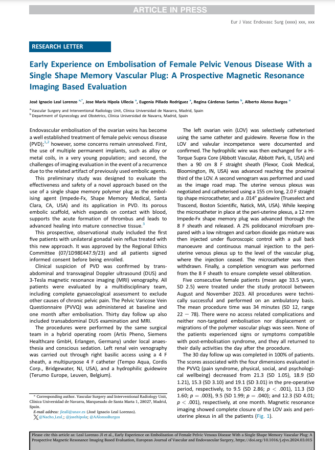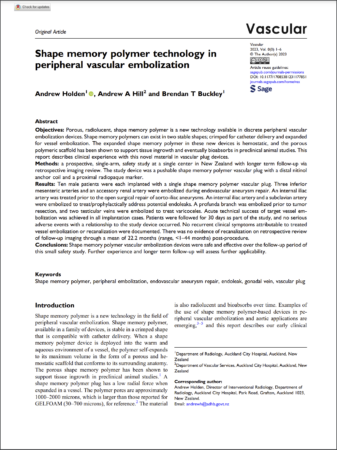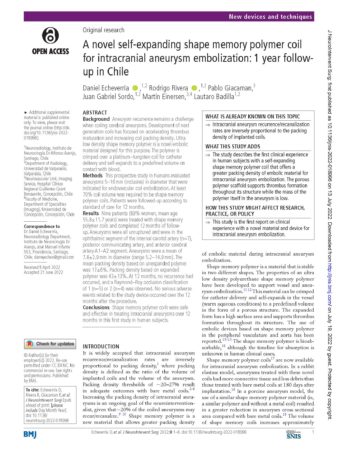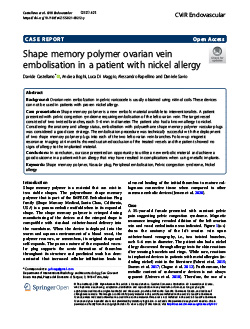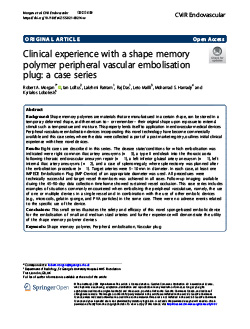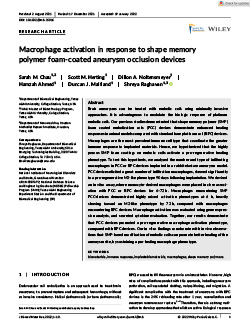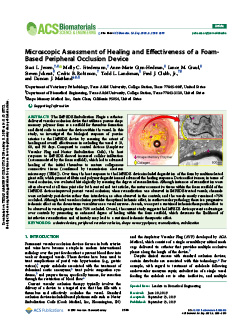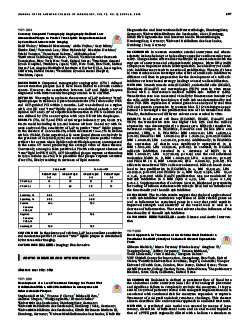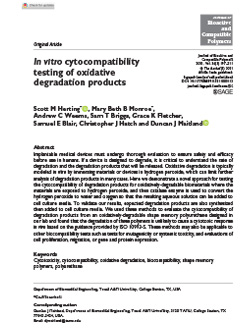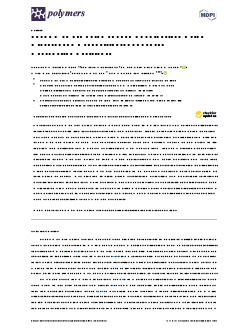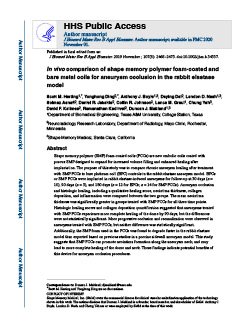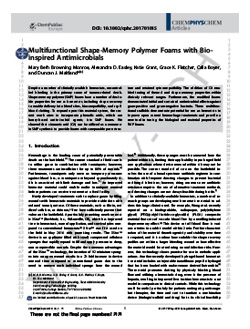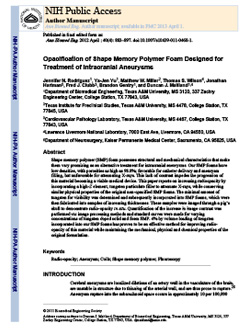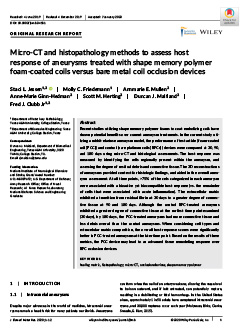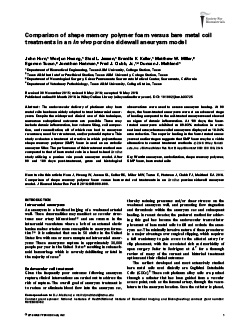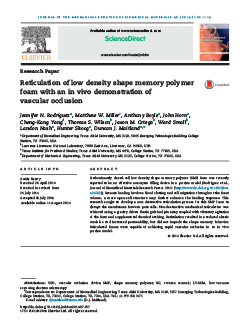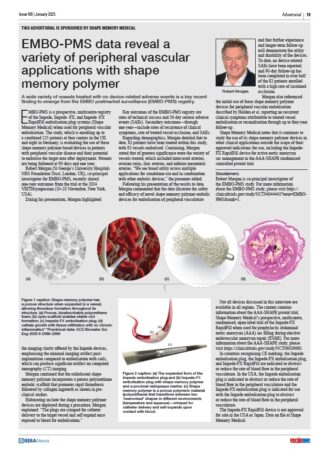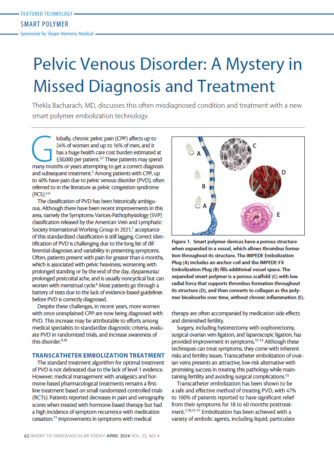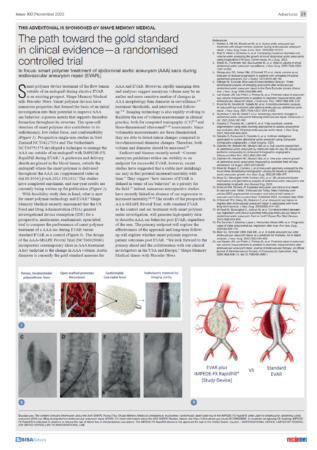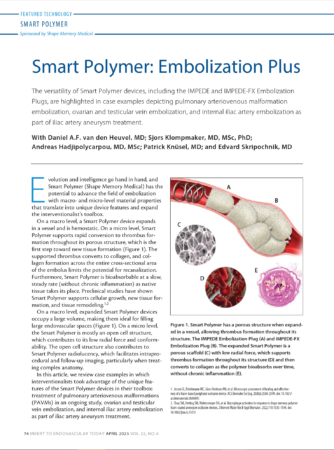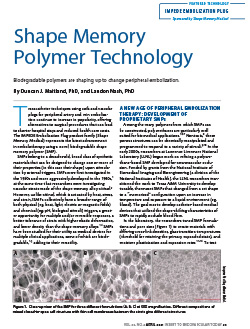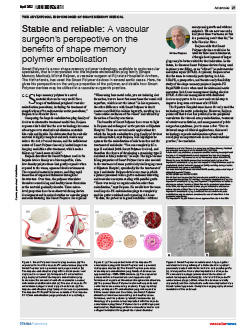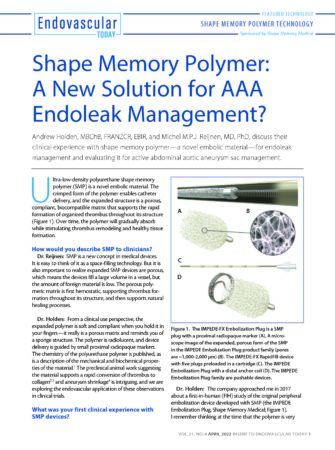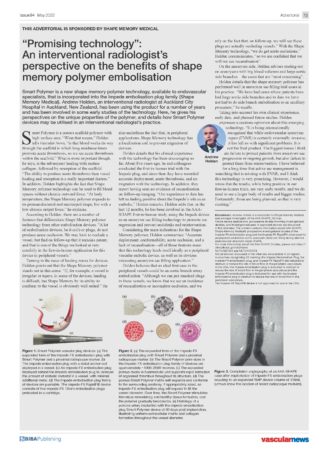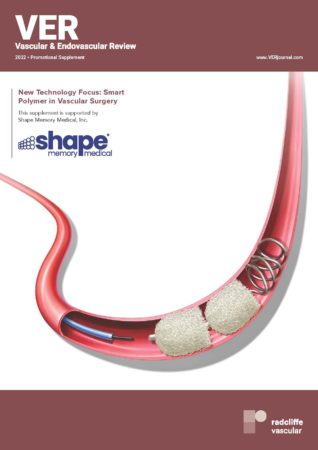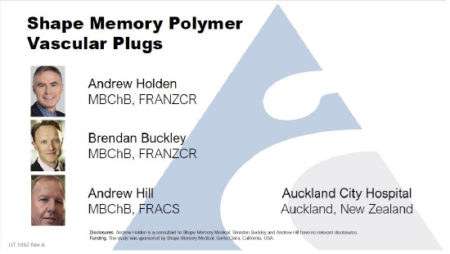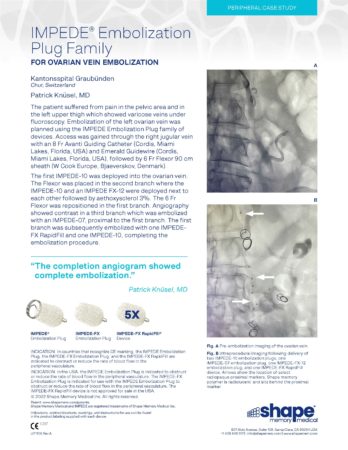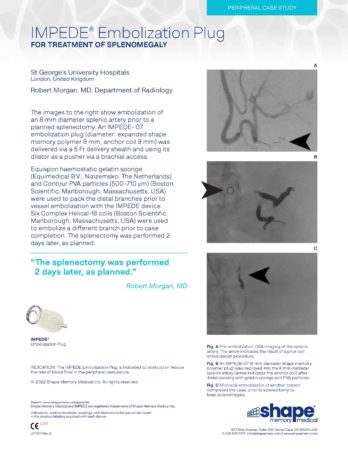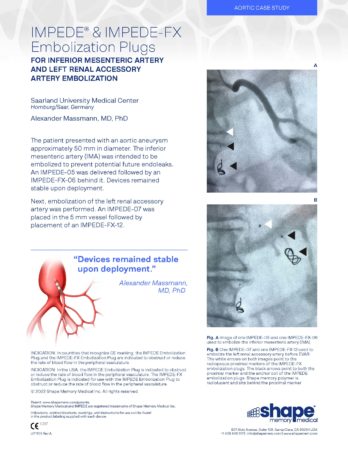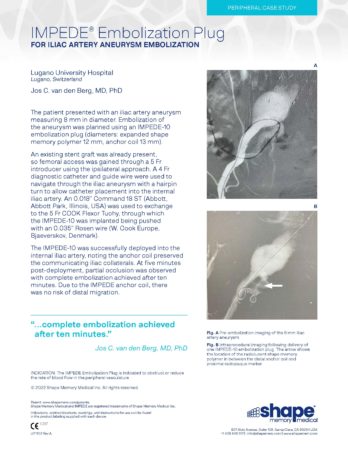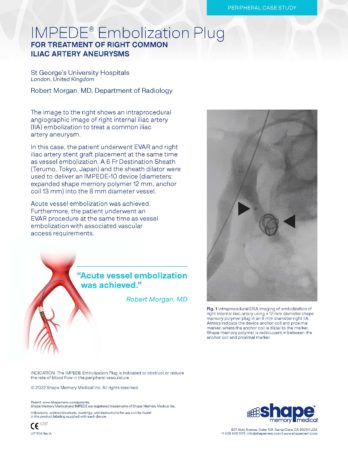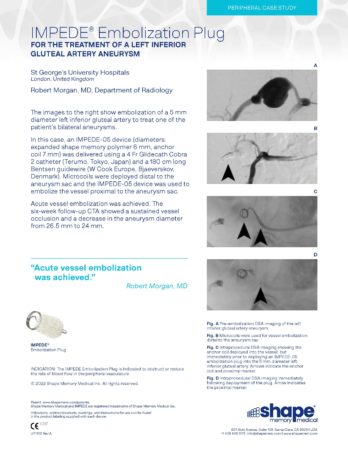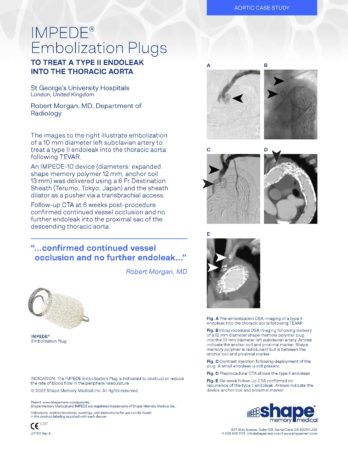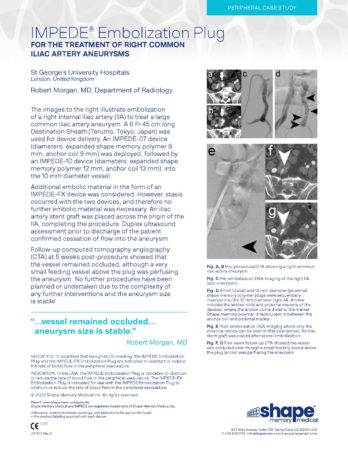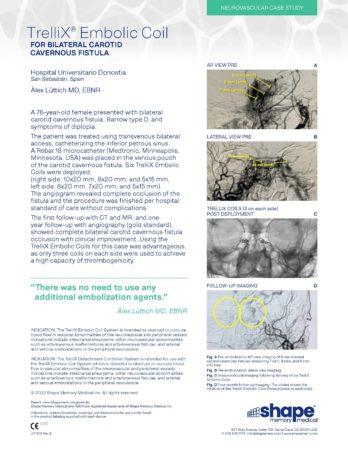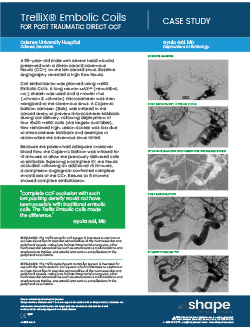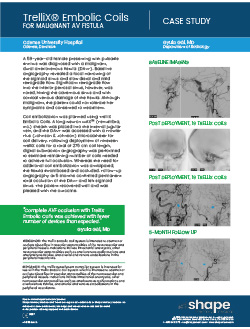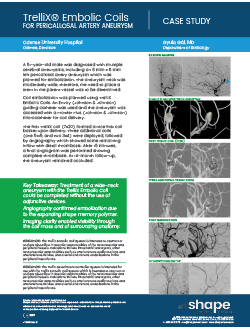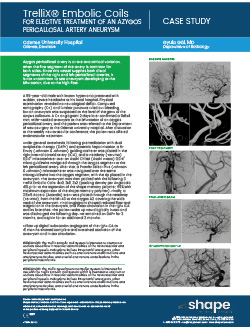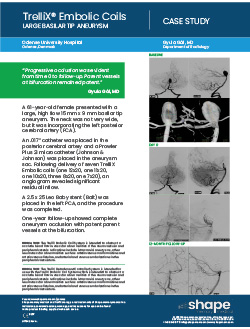Clinical & Preclinical
Go to
Publications
Early Experience on Embolisation of Female Pelvic Venous Disease With a Single Shape Memory Vascular Plug: A Prospective Magnetic Resonance Imaging Based Evaluation
José Ignacio Leal Lorenzo, Jose María Hípola Ullecia, Eugenia Pillado Rodríguez, Regina Cárdenas Santos, and Alberto Alonso Burgos
“None of the patients experienced signs or symptoms compatible with post-embolisation syndrome, and they all returned to their daily activities the day after the procedure.”
Shape memory polymer technology in peripheral vascular embolization
Andrew Holden, Andrew Hill, and Brendan T Buckley
“Porous shape memory polymer vascular embolization devices were safe and effective over the follow-up period of this early clinical experience. Further experience and longer-term follow-up will determine further applicability of the novel shape memory polymer material.”
A novel self-expanding shape memory polymer coil for intracranial aneurysm embolization: 1-year follow-up in Chile
Daniel Echeverría, Rodrigo Rivera, Pablo Giacaman, Juan Gabriel Sordo, Martín Einersen, Lautaro Badilla
“The x-ray transparency of the polymer is extremely advantageous when performing intraprocedural angiography as it is easier to see through the aneurysm to verify complete exclusion of contrast from the sac.”
Shape memory polymer ovarian vein embolisation in a patient with nickel allergy
Davide Castellano, Andrea Boghi, Luca Di Maggio, Alessandro Rapellino and Daniele Savio
“In conclusion, our case presented an opportunity to utilise a new embolic material and achieve a good outcome in a patient with an allergy that may have resulted in complications when using metallic implants.”
Clinical experience with a shape memory polymer peripheral vascular embolization plug: a case series
Robert A. Morgan, Ian Loftus, Lakshmi Ratnam, Raj Das, Leto Mailli, Mohamad S. Hamady and Kyriakos Lobotesis
“This small series illustrates the safety and efficacy of this novel sponge-based embolic device for the embolisation of small and medium sized arteries and further experience will demonstrate the utility of the shape memory polymer devices.”
Publications (Preclinical)
Macrophage activation in response to shape memory polymer foam-coated aneurysm occlusion devices
Sarah M. Chau, Scott M. Herting, Dillon A. Noltensmeyer, Hamzah Ahmed, Duncan J. Maitland, and Shreya Raghavan
“Our previous studies demonstrated that shape memory polymer (SMP) foam coated embolization coils (FCC) devices demonstrate enhanced healing responses in animal models compared with standard bare platinum coil (BPC) devices. Macrophages are the most prevalent immune cell type that coordinate the greater immune response to implanted materials. Hence, we hypothesized that the highly porous SMP foam coatings on embolic coils activate a pro-regenerative healing phenotype…”
Microscopic Assessment of Healing and Effectiveness of a Foam- Based Peripheral Occlusion Device
Staci L. Jessen, Molly C. Friedemann, Anne-Marie Ginn-Hedman, Lance M. Graul, Steven Jokerst, Cedric B. Robinson, Todd L. Landsman, Fred J. Clubb, Jr., and Duncan J. Maitland
“Overall, the presence of multinucleated giant cells surrounding the IMPEDE polymer, the presumable presence of alternatively activated macrophages, and the deposition of mature collagen are appropriate host responses that indicate these vessels are not exhibiting an acute or chronic, mixed inflammatory reaction but have progressed toward a healing response.”
TCT-286 Novel Approach for Treatment of Aortic Stent Graft Endoleak: A Preclinical Feasibility Study of Catheter-Delivered Expandable Foam
Gilberto Melnick, Marco Ferrone, Nicolas Isaza, Genghua Yi, Yanping Cheng, Jeffrey Carpenter, Duncan Maitland, Todd Landsman, Juan Granada, and Grzegorz Kaluza
“This first attempt to contain an AAA endoleak with shape memory foam delivered through a standard guide catheter showed feasibility and satisfactory angiographic results.”
In vitro cytocompatibility testing of oxidative degradation products
Scott M Herting, Mary Beth B Monroe, Andrew C Weems, Sam T Briggs, Grace K Fletcher, Samuel E Blair, Christopher J Hatch, and Duncan J Maitland
“These methods were used to test degradation products from a SMP foam that has been investigated for use in occlusion devices, and it was found that the degradation of this material is unlikely to cause a cytotoxic response in vivo.”
Shape Memory Polymer Foams Synthesized Using Glycerol and Hexanetriol for Enhanced Degradation Resistance
Sayyeda Marziya Hasan, Grace K. Fletcher, Mary Beth Browning Monroe, Mark A. Wierzbicki, Landon D. Nash, Duncan J. Maitland
“These degradation-resistant systems have potential for use in vascular occlusion and other wound healing applications that benefit from permanent, space-filling shape memory behavior.”
In vivo comparison of shape memory polymer foam-coated and bare metal coils for aneurysm occlusion in the rabbit elastase model
Scott M. Herting, Yonghong Ding, Anthony J. Boyle, Daying Dai, Landon D. Nash, Solmaz Asnafi, Daniel R. Jakaitis, Collin R. Johnson, Lance M. Graul, Chung Yeh, David F. Kallmes, Ramanathan Kadirvel, Duncan J. Maitland
“Shape memory polymer (SMP) foam-coated coils (FCCs) are new embolic coils coated with porous SMP designed to expand for increased volume filling and enhanced healing after implantation. This study suggests that SMP FCCs can promote neointima formation along the aneurysm neck and may lead to more complete healing of the dome and neck.”
Multifunctional Shape-Memory Polymer Foams with Bio-inspired Antimicrobials
Mary Beth Browning Monroe, Alexandra D. Easley, Katie Grant, Grace K. Fletcher, Calla Boyer, Duncan J. Maitland
“These multifunctional scaffolds demonstrate potential for use as hemostats to improve upon current hemorrhage treatments and provide a new tool in tuning the biological and material properties of SMP foams.”
Opacification of shape memory polymer foam designed for treatment of intracranial aneurysms
Jennifer N. Rodriguez, Ya-Jen Yu, Matthew W. Miller, Thomas S. Wilson, Jonathan Hartman, Fred J. Clubb, Brandon Gentry, Duncan J. Maitland
“Shape memory polymer (SMP) foam possesses structural and mechanical characteristics that make them very promising as an alternative treatment for intracranial aneurysms.”
Micro-CT and histopathology methods to assess host response of aneurysms treated with shape memory polymer foam-coated coils versus bare metal coil occlusion devices
Staci L. Jessen, Molly C. Friedemann, Annmarie E. Mullen, Anne-Marie Ginn-Hedman, Scott M. Herting, Duncan J. Maitland, Fred J. Clubb Jr
“When considering cell types and extracellular matrix composition, the overall host response scores were significantly better in FCC-treated aneurysms (foam-coated coil) at the later time point. Based on the results of these metrics, the FCC device may lead to an advanced tissue remodeling response over BPC occlusion devices.”
Comparison of shape memory polymer foam versus bare metal coil treatments in an in vivo porcine sidewall aneurysm model
John Horn, Wonjun Hwang, Staci L. Jessen, Brandis K. Keller, Matthew W. Miller, Egemen Tuzun, Jonathan Hartman, Fred J. Clubb, Jr., Duncan J. Maitland
“The superior healing in the foam-treated aneurysms at earlier stages suggests that SMP foam may be a viable alternative to current treatment methods.”
Reticulation of low density shape memory polymer foam with an in vivo demonstration of vascular occlusion
Jennifer N Rodriguez, Matthew W. Miller, Anthony Boyle, John Horn, Cheng-Kang Yang, Thomas S. Wilson, Jason M. Ortega, Ward Small, Landon Nash, Hunter Skoog, Duncan J. Maitland
“Because healing involves blood clotting and cell migration throughout the foam volume, a more open-cell structure may further enhance the healing response…”
Publications – Editorial
EMBO-PMS Data Reveal a Variety of Peripheral Vascular Applications with Shape Memory Polymer
Robert Morgan, MD, discusses EMBO post market surveillance (EMBO-PMS) registry
The study, which is enrolling up to a combined 125 patients at four centers in the UK and eight in Germany, is evaluating the use of shape memory polymer-based devices in patients with peripheral vascular disease and their potential to embolize the target area after deployment.
Pelvic Venous Disorder: A Mystery in Missed Diagnosis and Treatment
Thekla Bacharach, MD, discusses this often misdiagnosed condition and treatment with a new smart polymer technology.
Due to their composition of compliant and low-density material, smart polymers are a novel method of treating PVD via transcatheter They improve visibility of surrounding anatomies and minimize CT compared to conventional metal coils or plugs which can obscure visibility during future procedures.
Smart Polymer: Embolization Plus
With Daniel A.F. van den Heuvel, MD; Sjors Klompmaker, MD, MSc, PhD; Andreas Hadjipolycarpou, MD, MSc; Patrick Knüsel, MD; and Edvard Skripochnik, MD
The versatility of Smart Polymer devices, including the IMPEDE and IMPEDE-FX Embolization Plugs, are highlighted in case examples depicting pulmonary arteriovenous malformation embolization, ovarian and testicular vein embolization, and internal iliac artery embolization as part of iliac artery aneurysm treatment.
Shape Memory Polymer Technology: Biodegradable polymers are shaping up to change peripheral embolization.
By Duncan J. Maitland, PhD, and Landon Nash, PhD
“Studies have shown that the SMP-based IMPEDE Embolization Plug product family offers predictable, controlled, high-volume fill, encouraging stasis and rapid thrombus formation with progressive healing as the biodegradable SMP is replaced by mature connective tissue over time.”
Stable and reliable: A vascular surgeon’s perspective on the benefits of shape memory polymer embolisation
Smart Polymer is a new shape memory polymer technology, available to endovascular specialists, that is incorporated into the Impede embolisation plug family (Shape Memory Medical). Michel Reijnen, a vascular surgeon at Rijnstate Hospital in Arnhem, The Netherlands, has used the Smart Polymer devices in several aortic cases. Here, he gives his perspective on the unique properties of the polymer, and details how Smart Polymer devices may be utilised in a vascular surgeon’s practice.
Shape Memory Polymer: A New Solution for AAA Endoleak Management?
Andrew Holden, MBChB, FRANZCR, EBIR, and Michel M.P.J. Reijnen, MD, PhD, discuss their clinical experience with shape memory polymer—a novel embolic material—for endoleak management and evaluating it for active abdominal aortic aneurysm sac management.
“Promising technology”: An interventional radiologist’s perspective on the benefits of shape memory polymer embolization
Smart Polymer is a new shape memory polymer technology, available to endovascular specialists, that is incorporated into the Impede embolisation plug family (Shape Memory Medical). Andrew Holden, an interventional radiologist at Auckland City Hospital in Auckland, New Zealand, has been using the product for a number of years and has been involved in some early studies of the technology. Here, he gives his perspectives on the unique properties of the polymer, and details how Smart Polymer devices may be utilised in an interventional radiologist’s practice.
New Technology Focus: Smart Polymer in Vascular Surgery
A new smart polymer technology developed by Shape Memory Medical is available to endovascular specialists. The shape memory polymer is incorporated into vascular plugs and coils. Dr. Ross Milner, a vascular surgeon at University of Chicago Medicine, gives his perspective on the properties of the shape memory polymer and how smart polymer devices may be used in vascular surgery.
Clinical Trial Presentations

CX co-chairs host discussion on studies looking at pre-emptive AAA sac management with the novel shape memory polymer and its potential to improve post-EVAR sac regression.
Dittmar Bӧckler, MD, Andrew Holden, MBChB, and Marc Schermerhorn, MD – Charing Cross Symposium 2024
Professor Holden highlighted data from the AAA-SHAPE early feasibility studies that evaluated the IMPEDE-FX Embolization Plug for management of AAA sacs at the time of EVAR. This novel technology is comprised of shape memory polymer, a porous polyurethane scaffold that supports rapid conversion to organized thrombus, that Professor Holden reports could lead to sac shrinkage. Schermerhorn also highlighted the need for evidence from a randomized clinical trial and announced the initiation of the AAA-SHAPE Pivotal Trial.

Active sac management represents a “step forward” for EVAR
Jan Heyligers, MD, PhD, & Michel Reijnen, MD, PhD – VEITH Symposium 2023
“Despite significant technological improvements since its inception, endovascular repair of abdominal aortic aneurysms (AAA) is still associated with some of the same problems we experienced nearly 30 years ago,” Michel Reijnen (Arnhem, The Netherlands) remarked at the VEITHsymposium 2023 (14–18 November, New York, USA). One of these issues—and a significant unmet need in the aortic field—is the failure of an AAA to regress post-endovascular aneurysm repair (EVAR).
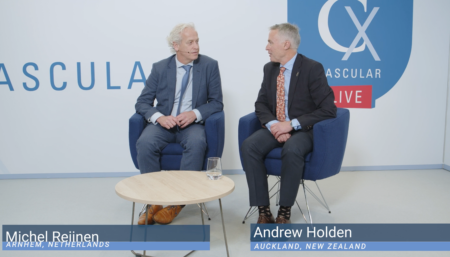
Shape memory polymer: “Another step down the road” toward active aneurysm sac management
Andrew Holden, MBChB, FRANZCR, EBIR & Michel Reijnen, MD, PhD – Charing Cross Symposium 2023
“There is an increasing awareness that we need to get aneurysm sacs to regress after endovascular aneurysm repair [EVAR],” Andrew Holden (Auckland, New Zealand) stated during a recent discussion with Michel Reijnen (Arnhem, The Netherlands) on potential solutions in this space from Shape Memory Medical.
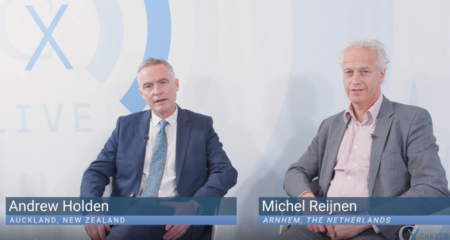
Shape Memory Polymer addresses an “unmet need” for EVAR
Andrew Holden, MBChB, FRANZCR, EBIR & Michel Reijnen, MD, PhD – Charing Cross Symposium 2022
“When you compare it to other embolic agents it is completely different.”
Clinical Trials
Abdominal Aortic Aneurysm Sac Healing and Prevention of Endoleaks (AAA-SHAPE)
AAA-SHAPE is a prospective, multicenter trial to determine the safety and efficacy of the IMPEDE-FX Embolization Plug and/or IMPEDE-FX Rapid Fill to fill an abdominal aortic aneurysm (AAA) sac outside of an endovascular aneurysm repair (EVAR) stent graft.
Abdominal Aortic Aneurysm Sac Healing and Prevention of Expansion (AAA-SHAPE)
The AAA-SHAPE Pivotal Trial is intended to determine the safety and effectiveness of IMPEDE-FX RapidFill to increase the percentage of subjects with shrinkage of the abdominal aortic aneurysm sac when used as an adjunct to on-label endovascular aneurysm repair (EVAR) stent graft treatment in trial subjects considered candidates for elective EVAR.
IMPEDE and IMPEDE-FX Embolization Plug Post-Market Surveillance (EMBO-PMS)
EMBO-PMS is a prospective, multicentre, post-market surveillance study of the IMPEDE and IMPEDE-FX Embolization Plug System.
Aneurysm Packing With the Expandable TrelliX Coil System – A Prospective Safety Study (APEX-FIH)
APEX-FIH is a first-in-human, open-label prospective multicenter study of the TrelliX Embolic Coil System for use in embolization of the medium to large, ruptured or unruptured cerebral aneurysms.
Case Studies
TrelliX® Embolic Coils for Pericallosal Artery Aneurysm
Odense University Hospital, Odense Denmark – Guyla Gál, MD
Treatment of a wide-neck aneurysm with the TrelliX Embolic Coil could be completed without the use of adjunctive devices. Angiography confirmed embolization due to the expanding shape memory polymer. Imaging clarity enabled visibility through the coil mass and surrounding anatomy.
TrelliX® Embolic Coils for Elective Treatment of an Azygos Pericallosal Artery Aneurysm
Odense University Hospital, Odense Denmark – Guyla Gál, MD
Azygos pericallosal artery is a rare anatomic variation, when the first segment of the artery is common for both sides. Since this vessel supplies both distal segments of the right and left pericallosal arteries, it is not uncommon to see the aneurysm developing at the bifurcation, due to the high flow.
